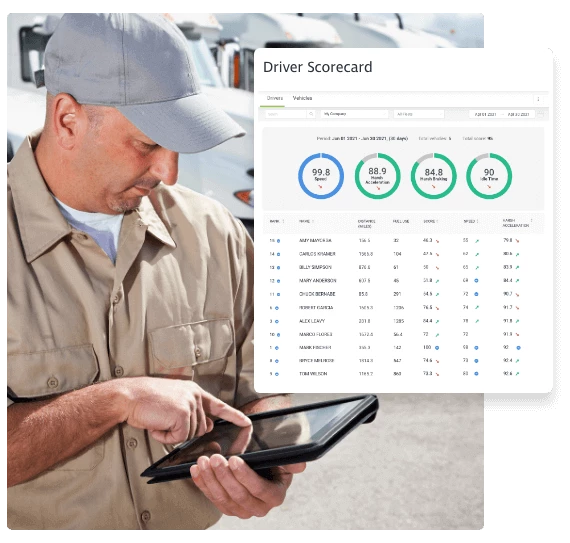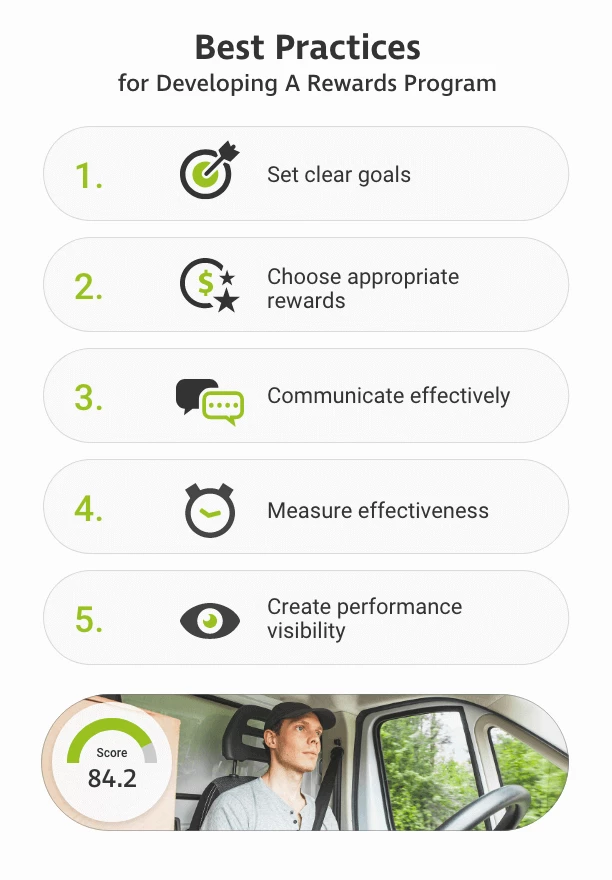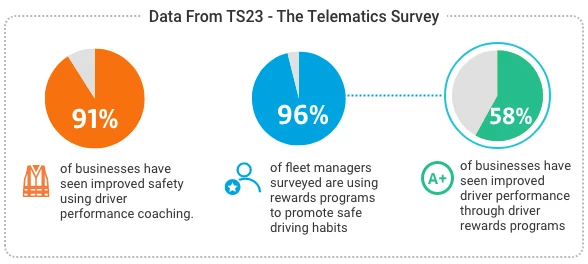Key Takeaway
Fleet safety is a top priority for businesses that rely on commercial drivers for the delivery of goods and services. Accidents involving commercial vehicles can have serious consequences, including damage to people, property, and finances. One of the best ways to prevent these incidents is by building a culture of safety within your company, starting with the creation of a commercial driver safety program that promotes safe driving practices.
In this article, we will explore the benefits of a commercial driver safety and rewards program. We’ll also cover tips for using driver scorecards, how to design an effective rewards program, and ways to turn data into actions to improve fleet safety.
Table of Contents
- What Are Driver Scorecards?
- Developing an Effective Commercial Driver Safety Program
- Using Technology to Promote Fleet Safety
- Fleet Safety Insights from Our TS23 Survey
What Are Driver Scorecards?
Driver scorecards are arguably the most important piece of any driver safety program. Using data captured by telematics devices, these scorecards can be used to measure and monitor driver performance. These highly flexible and customisable tools can be used to set thresholds for performance metrics, track individual trends, and offer many other insights into daily operations.
With this information, businesses can identify both the highest-performing and lowest-performing drivers in the fleet by comparing all drivers to established benchmarks. From there, underperforming drivers can be offered additional coaching or training to raise performance, while high-performing drivers can be recognised and rewarded for their accomplishments.

Developing an Effective Commercial Driver Safety Program
Rewards programs can be an effective way to encourage safe driving habits while motivating drivers to improve performance. However, developing an effective rewards program requires careful planning and execution to balance cost and effectiveness.
Here are some basic best practices for developing a rewards program:
- Set clear goals. Before developing a rewards program, businesses should establish clear goals and objectives both for the company and for individual drivers. These goals should be specific, measurable, and achievable.
- Choose appropriate rewards. Rewards should be meaningful and motivating for drivers. Incentives must be strong enough to elicit the intended effects of the safety program.
- Communicate effectively. Clear communication is an essential component of a successful rewards program. Drivers must be able to clearly understand how a program works, what rewards are available, and how they can achieve performance incentives. Data shows that 96% of fleet operators who have improved safety are rewarding performance, further highlighting the importance of effective communication.
- Measure effectiveness. Businesses should track the effectiveness of their rewards programs over time to ensure they are achieving their desired safety outcomes. Metrics such as accident rates, driver turnover, and driver performance can all be used to measure the effectiveness of the program.
- Create performance visibility. Drivers should be able to see their scoring in real-time, allowing them to compare their performance against benchmarks and their peers. With driver scorecards, this functionality can be easily implemented into a rewards program.

Using Technology to Promote Fleet Safety
Technology can play a key role in promoting fleet safety if implemented correctly. By using telematics, driver performance can be tracked in real-time to provide feedback on driving habits.
To get the most out of fleet management software, businesses should take the following steps:
- Choose the correct technology. The best telematics platforms are customizable and scalable based on the needs of the business.
- Train drivers. Drivers should be trained on how to use fleet management software. They should also clearly understand how it will be used to track their performance.
- Use data effectively. Data can provide valuable insights into day-to-day operations, but only if it’s actionable. Be sure to take advantage of any reporting capabilities to turn data into decisions.
- Monitor performance over time. Businesses should monitor driver performance on an ongoing basis to ensure performance metrics are being met. Drivers not meeting standards should be provided with additional coaching and training as needed.
Fleet Safety Insights from Our TS23 Survey
Our TS23 Global Telematics Survey highlighted several significant trends regarding telematics data and fleet safety. According to the survey, 91% of businesses have seen improved safety using driver performance coaching. Additionally, 96% of fleet managers surveyed are using rewards programs to promote safe driving habits. The survey also found that 58% of businesses have seen improved driver performance through driver rewards programs, which emphasizes the value of these programs when it comes to improving fleet safety.

The benefits of an effective commercial driver safety program go beyond improved safety metrics. Businesses are investing in training, development, and rewards programs to attract and retain talented drivers. Over the long term, this can significantly improve fleet safety and performance, and fleet management software can be used to gain a competitive advantage in the marketplace .
Create a Safer, More Effective Fleet with TN360
TN360 from Teletrac Navman is the ideal starting point for your company’s commercial driver safety program. With AI-powered telematics you can elevate your operations through enhanced fleet safety, increased performance, and maximum efficiency.
To learn more about everything Teletrac Navman and TN360 can do for you, contact us today. You can also build your custom solution directly from our website with our online tool.

